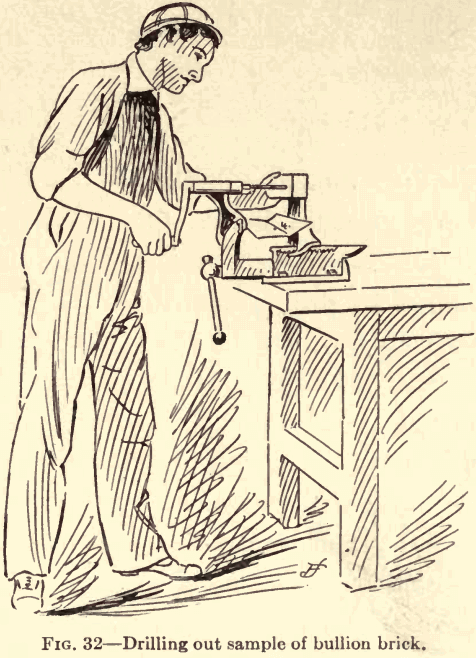Fire Assay of Antimony
Usual Charge Mix 10 grams of the pulped ore with 40 grams of pulverized potassium cyanide. Melting Put the charge into a 20 gram crucible or one of equivalent capacity, and cover the top of the charge with about 10 grams of dry table salt. The salt cover prevents the charge from boiling over the […]
Gold Bullion Assay

Drilling Bullion Bar for Sampling Bullion submitted for assay is usually brought in the form of bars, bricks, slugs or buttons, and a sample of bullion in this form is best obtained by drilling into the brick or slug with a small bit 3/16″ in diameter (Fig. 32). Drill enough so that the shavings or […]
Scorification

Definition of Term Scorification: Scorification may be defined as a reduction and a partial or preliminary cupellation successively performed in the same container without removal of the container from the muffle until volatilization is stopped by the slag entirely covering the charge. When is Scorification Assay Used Scorification is the proper method of assaying copper mattes. […]
How to Assay Gold & Silver Ore

Classification of Ores In fluxing ore for gold and silver, first determine the nature of the sample submitted for assay. Three different classifications may be made in the preliminary examination of ores; first, pure quartz (very glassy or vitreous); second, no quartz (plastic and free from grit); third, a mixture of these two extremes which […]
Bulk Sample Selection & Preparation

Bulk Sampling The first step in assaying is to obtain a sample, and it is all important that the portion selected should be representative of the entire quantity (Fig. 1). No special pieces should be picked from the bulk, but the desired quantity is taken indiscriminately from the entire original parcel. Crushing Grind or break […]
How to Make Cupels

Make 200 good cupels, as follows: Take the box used for the purpose and fill with bone-ash, add water and mix. Use as many ounces of water as pounds of bone-ash. The right amount of water has been added when the bone-ash loses its harsh, gritty feeling, and at the same time is not pasty. A […]
Assay Laboratory Instructions

These instruction sheets have been prepared in this form to take the place of mimeograph copies which were formerly used by students electing the course in fire assaying at the University of California. These notes are concise directions for the carrying out of certain laboratory work, and in no wise cover the ground of the […]
Volatilization in Assaying

It is common to blame irregular assay results upon volatilization and much has been written upon the subject, but there is no real evidence that, in a properly conducted assay, the loss of either gold or silver by volatilization is sufficient to affect appreciably the result, even when arsenic or antimony may be present. Bulk […]
Fire Assaying History
The beginning history of fire assaying can be traced to the finds in Troy II (about 2600 B.C.) and in the Cappadocian Tablets (2250-1950 B.C.). These finds prove that very pure silver was made in the twenty-fifth century B.C. From this evidence we must conclude that the cupellation process, and therefore fire assaying, was invented […]
Assaying

Assaying for ruthenium, rhodium, palladium, silver, osmium, iridium, platinum, gold is performed by fire assay. This ancient form of quantitative chemical analysis by which metals are separated and determined in ores and metallurgical products with the aid of heat and dry reagents. At present, this technique is used principally to preconcentrate the noble metals from […]
